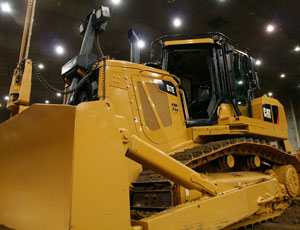The world's first diesel-electric hybrid bulldozer will carry a price tag that is about $100,000 more, or 20% higher, than a comparable non-hybrid machine. But will pay for itself in about two-and-a-half years, Caterpillar Inc. managers said June 23 at the company's training facility in Edwards, Ill.

The D7E, which begins production in October, will come with a manufacturer-recommended list price of $600,000, said David E. Nicoll, product execution manager. That is about 20% more than the current D7R, he added, but 12% less than the next-highest model, the D8T.
"Some say it feels like it has D8 power," said Nicoll. Cat developed the hybrid to create a fuel-efficient dozer that combines the best performance characteristics of a production dozer--high power and torque--with the tight steering radius of a finish dozer.
Though such a high premium is unusual for a piece of construction machinery, over the life of the machine, the D7E is expected to save 30% in owning-and-operating costs, primarily in fuel but also productivity, maintenance and other efficiencies of hybrid drive. Under Cat's simple-payback analysis, the D7E pays for itself in under three years.
"It means the accountants are happy," Nicoll said. The machine also addresses sustainability by burning 30% less fuel and emitting fewer pollutants. Overall, the D7E is up to 25% more fuel efficient than today's D7R but uses a smaller diesel engine that runs largely at a constant 1,800 rpm. Cat measures fuel efficiency in terms of material moved per gallon of fuel.
Though the D7 stands in the middle of the Cat dozer line, it is typically not a high-volume seller in North America. But Cat hopes to change that with the D7E's fuel-economy benefits. Last year, earthmoving manufacturers sold 2,000 D6-sized tractors in North America and 700 D8s. For the D7-size class, only 300 were sold; though worldwide, the construction industry bought 4,000. Initially, the D7E will be available only in North America. Cat will continue to sell the D7R through mid-2010.
Changing from the trademark "high drive" elevated sprocket on the D7E was not taken lightly, even at one point requiring input from the chief executive's office. "Caterpillar is not getting away from the elevated sprocket," Nicoll explained, adding that larger machines will continue to keep the trademark design because they benefit more from it than smaller dozers. The D7E's electric motors also enable the sprockets to perform lock-track turns, making it more maneuverable than the D7R.
A user panel was on hand to offer firsthand accounts of prototype testing. Daniel R. Plote of Hoffman Estates, Ill.-based roadbuilder Plote Construction Inc., commented that the D7E prototype he is trying out is as productive as one of his D8Ts. "It's amazingly keeping up, pound for pound completely, and the fuel economy is incredible," he said. "I'm really excited about the cost savings."
When the machine initially launched at CONEXPO 2008 in Las Vegas, Cat was reticent to label it a hybrid because it does not store power onboard the vehicle.
"There is a lot of focus on what I'm going to call hybrid technologies," said Nicoll. "We felt that the term 'Ohybrid' since we last got together 15 months ago has become a little diluted, in my opinion, so to include a lot of different technologiess. We don't have plans to paint hybrid on the side of the machine, by any means, but at the same time we do believe it is a diesel-electric hybrid."
Some users said they would like to see hybrid painted on the machine to help the construction industry clean up its dirty image. "We are going green; unfortunately our industry is probably labeled as anything but green," Plote said. "The industry needs help in reference to the public eye."
Mike Betz, engineering team leader, noted that the as the electric drive changes direction, such as every 30-40 seconds in slot dozing, the engine flywheel's momentum temporarily stores power as the machine stops and reverses, similar to regenerative braking on an automotive hybrid.
"It's not much, but it helps," he said. Cat is considering its hybrid drive for other machines but has not yet made any formal plans, he added. Research and development of the D7E, which began in the late 1990s, cost Cat millions of dollars and generated more than 100 patents, some of which are still pending.


Post a comment to this article
Report Abusive Comment